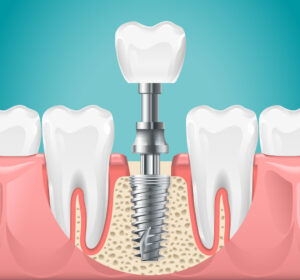Dental implant surgery replaces tooth roots with metal, screwlike posts and replaces damaged or missing teeth with artificial teeth that look and work much like real ones. Dental implant surgery can be a helpful choice when dentures or bridgework fit poorly. This surgery also can be an option when there aren’t enough natural teeth roots to support dentures or build bridgework tooth replacements.
The type of implant and the condition of the jawbone guide how dental implant surgery is done. This surgery may involve several procedures. The major benefit of implants is solid support for the new teeth — a process that requires the bone to heal tightly around the implant. Because this bone healing requires time, the process can take many months.
Dental implants are surgically placed in your jawbone and serve as the roots of missing teeth. Because the titanium in the implants fuses with your jawbone, the implants won’t slip, make noise or cause bone damage like fixed bridgework or dentures might. And the materials can’t decay like your own teeth.

Dental implants may be right for you if you:
Dental implant surgery usually is an outpatient surgery done in stages, with healing time between procedures. The process of placing a dental implant involves several steps:
The whole process can take many months from start to finish. Much of that time is for healing and waiting for the growth of new bone in your jaw. Depending on your situation, the specific procedure done and the materials used, certain steps can sometimes be combined.
Once the surgeon places the metal implant post in your jawbone, osseointegration (os-e-o-in-tuh-GRAY-shun) begins. Osseointegration is the process of forming a connection between the bone and the implant. During this process, the jawbone grows into, and joins with, the surface of the dental implant. This process helps provide a solid base for your new artificial tooth — just as roots do for your natural teeth. The process can take several months.
When osseointegration is complete, you may need more surgery to place the abutment — the piece where the crown eventually attaches. Usually, this minor surgery is done in an outpatient setting using medicine that numbs the area that’s worked on.
To place the abutment, your surgeon:
Your surgeon may attach the abutment to the dental implant metal post when the post is implanted. That means you won’t need an extra surgical step. But because the abutment juts past the gumline, you can see it when you open your mouth. It will be that way until your surgeon completes the tooth replacement. Some people don’t like the way that looks and prefer a separate procedure to place the abutment.
After your surgeon places the abutment, your gums must heal for at least two weeks before your general dentist or prosthodontist can attach the artificial tooth.
Once your gums heal, your general dentist or prosthodontist makes more impressions of your mouth and remaining teeth. These impressions are used to make the crown — your realistic-looking artificial tooth. Your general dentist or prosthodontist can’t place the crown until your jawbone is strong enough to support use of the new tooth.
You and your dentist or prosthodontist can choose artificial teeth that are:
Register for a Consultation, and Delia Will Contact You!
For detailed information about our services, please leave your phone number with us, and our specialists will call you back.